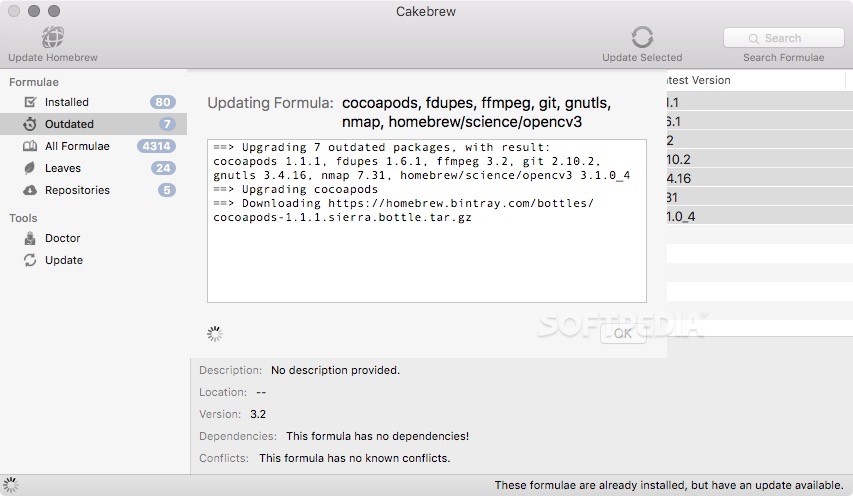
- #TOP CAKEBREW PACKAGES INSTALL#
- #TOP CAKEBREW PACKAGES UPGRADE#
- #TOP CAKEBREW PACKAGES LICENSE#
- #TOP CAKEBREW PACKAGES DOWNLOAD#
- #TOP CAKEBREW PACKAGES MAC#
#TOP CAKEBREW PACKAGES DOWNLOAD#
Download VirtualHostXĮxisting users may download the most recent versions of VirtualHostX.Įxisting users may download the most recent versions of Hostbuddy.Įxisting users may download the most recent version of Hobo. It’s been a privilege helping you get work done. Many of you have been customers for well over a decade. Thanks to everyone for your support of VirtualHostX throughout the years. With VirtualHostX being sunset, sales of its sibling apps, Hostbuddy and Hobo, are ending, too.
#TOP CAKEBREW PACKAGES LICENSE#
Your existing license for VirtualHostX will continue working indefinitely. No need to purchase additional seats.Īlong with the above, VirtualHostX will continue to be available for download.Īs of February 1, 2022, all auto-renewing subscriptions will be stopped and you will not be billed again.
#TOP CAKEBREW PACKAGES INSTALL#
If you have a license for VHX, feel free to install it on as many Macs as you want. Activation limits for existing customers have been removed. Support for future versions of macOS is not guaranteed.Ħ. Bug fixes will be shipped as necessary.Ĥ. Your copy of VirtualHostX will continue working on Intel-based Macs.ģ. What happens next, and what does this mean for customers?ġ. As of November 24, 2021, I’m announcing that VirtualHostX is sunset as an actively developed product. None of those paths forward are tenable for many different reasons. Options included rebuilding VHX on top of Docker, requiring customers to pay for a third-party virtualization app such as Parallels or VMWare, or building my own virtual machine layer on top of Apple’s system frameworks. I’ve spent the better part of the last year and a half investigating ways to bring VHX to Apple’s new machines. If you’ve been paying attention, you’ve noticed that VirtualHostX is not compatible with Apple Silicon Macs. Below are some Homebrew Cask commands to help you with installing and uninstalling GUI apps/casks.In June 2020, Apple announced their transition to M1 Macs – powered by their own CPUs, which began shipping later that year. Unlike installing regular packages (or command-line tools), installing graphical apps with cask requires you to use a slightly different set of commands.
#TOP CAKEBREW PACKAGES UPGRADE#
When you want to upgrade a package to its latest version:īrew uninstall package_name 2. If you want to learn more about any package, check out Homebrew Formulae. To do this, open the Terminal app and run your commands using the following syntaxes.
#TOP CAKEBREW PACKAGES MAC#
If you want to install a command-line utility/formulae on your Mac with Homebrew, you’ll need to use brew. Installing Command-Line Utilities With Homebrew Note: Homebrew packages are referred to as formulae, whereas Homebrew Cask apps are called casks.ĭepending on what package you want to install on your Mac - command-line utility or graphical app - you’ll need to either use Brew or Brew Cask for the installation.

There are several advantages to using Homebrew for managing utilities and apps on your Mac. So you can use it when you want to install, update, or remove graphical apps on your Mac, such as Google Chrome, VLC, Spotify, Atom, etc.Īll your installed Homebrew packages live under /usr/local/Cellar and are linked to /usr/local/bin to make it easier for you to find and launch GUI-based apps right from the Applications directory, just like any other GUI app on your Mac. Not just that, Homebrew also has an extension, called Cask (or Homebrew Cask), to help you with the management of GUI-based apps. Once you’ve tapped into the repository, you can install the package using either the brew command or the brew cask command, depending on whether it. It allows you to install, update, and remove programs (apps/utilities) on your Mac right from the command-line and provides access to various command-line utilities, including git, wget, nvm, and openssl. Homebrew is a free and open-source package manager for macOS and Linux operating systems. Managing Mac Programs Efficiently Using Homebrew.Installing Packages from Other Repositories


 0 kommentar(er)
0 kommentar(er)
